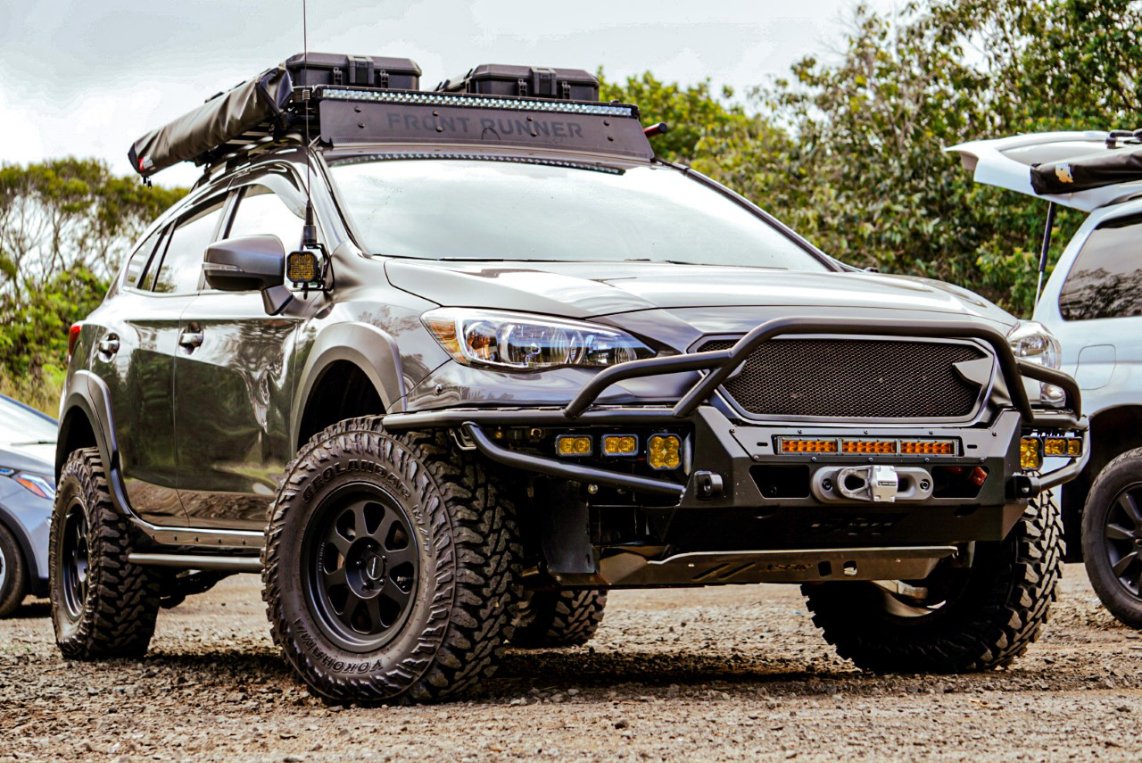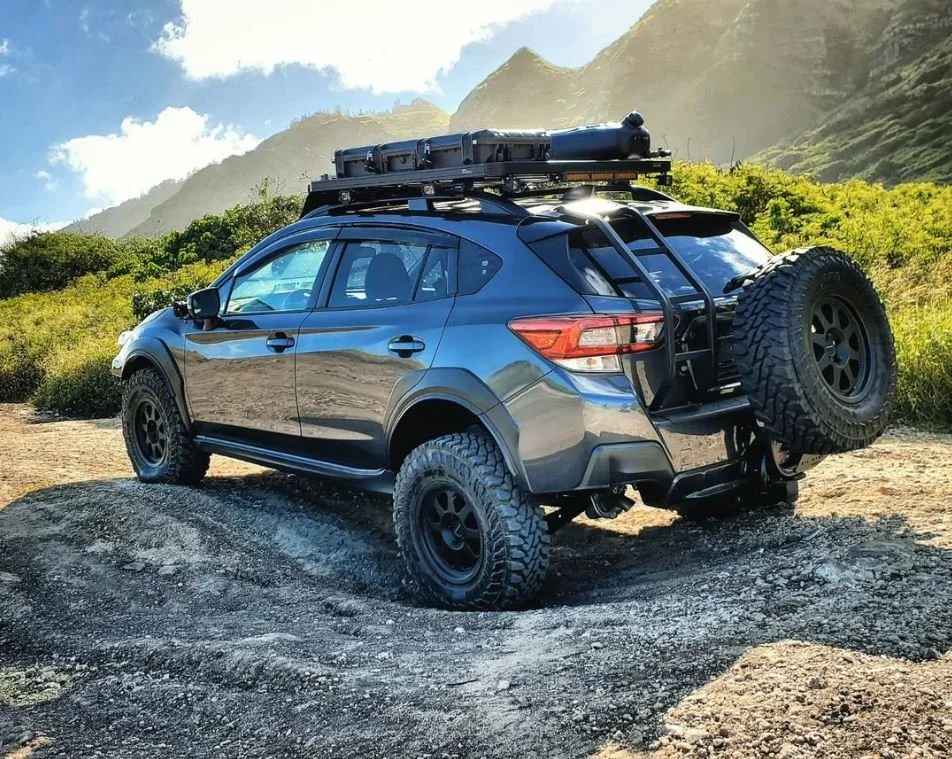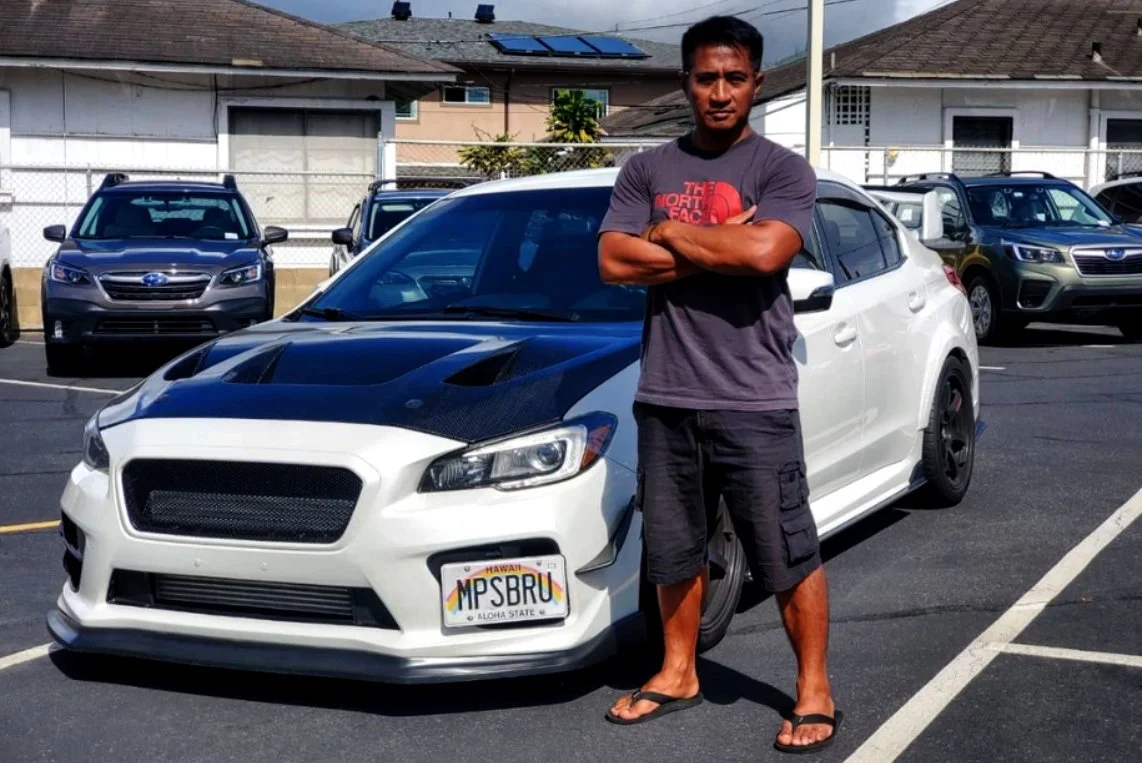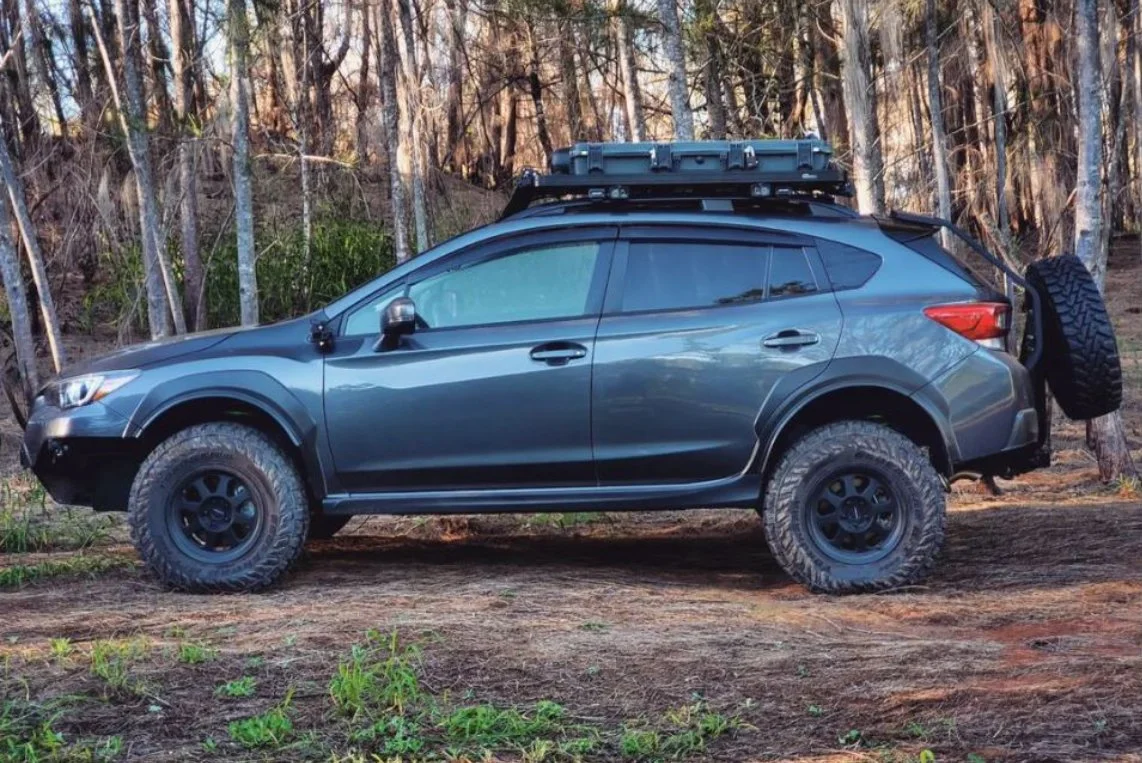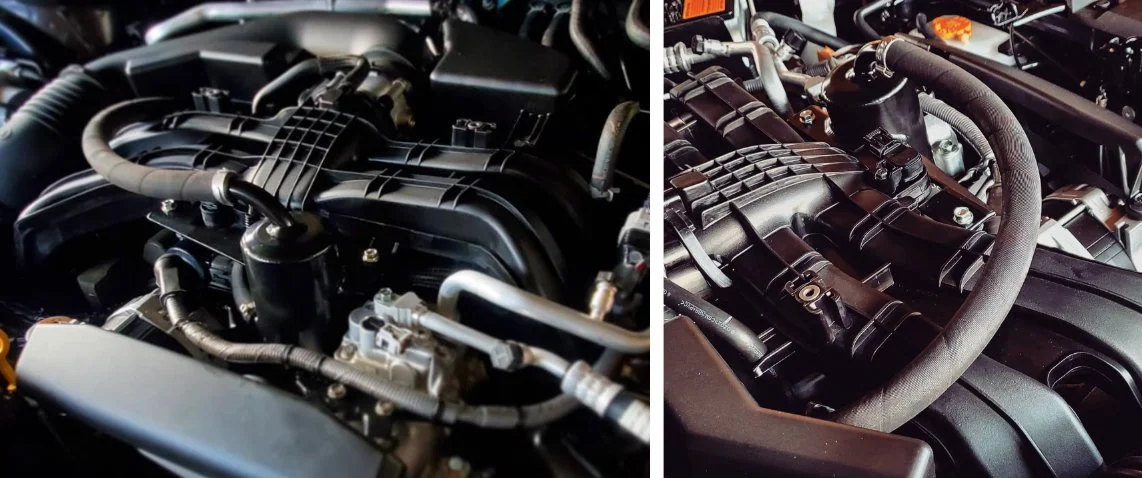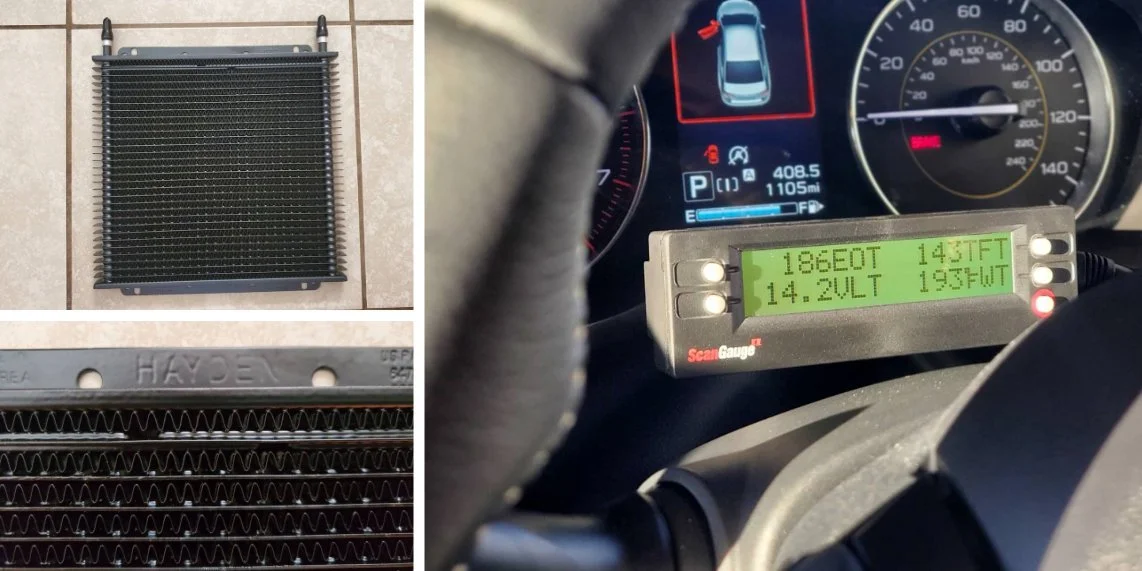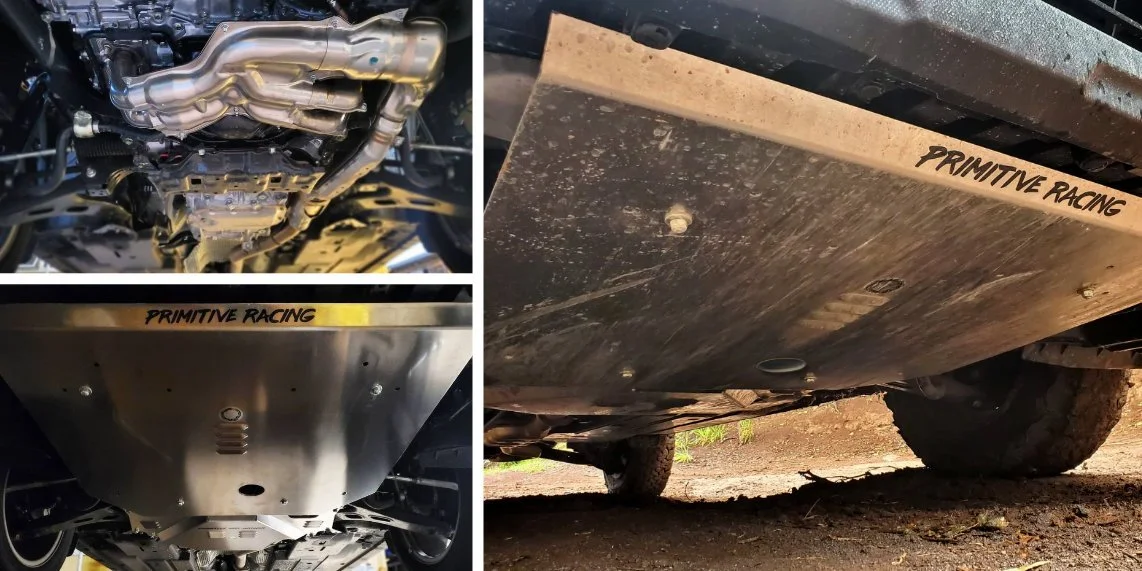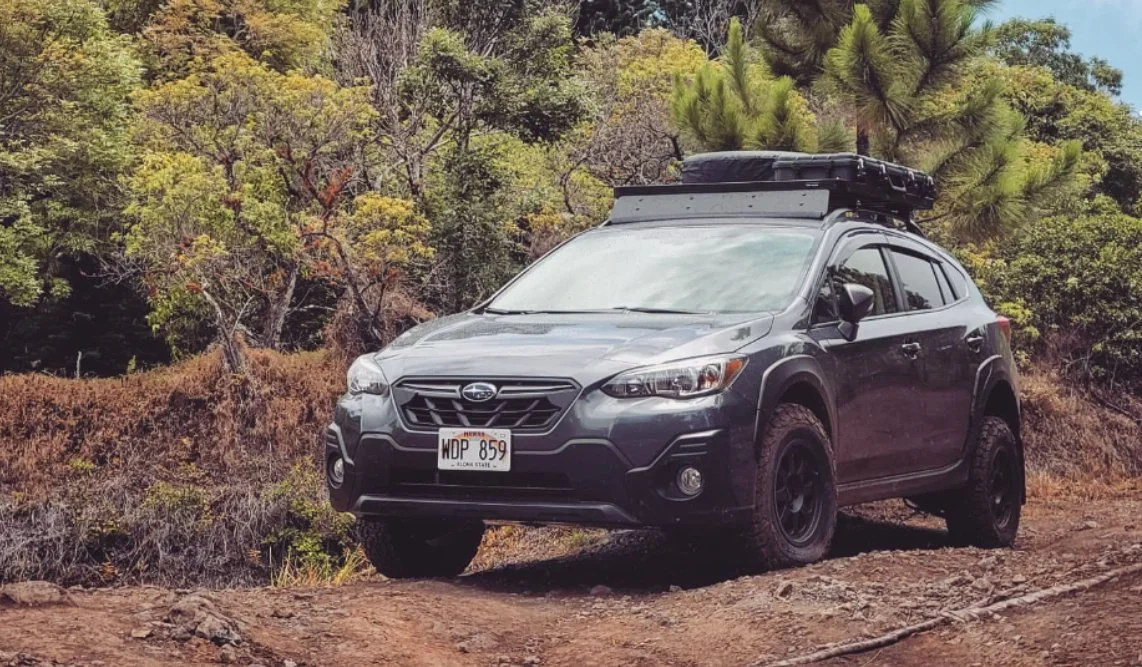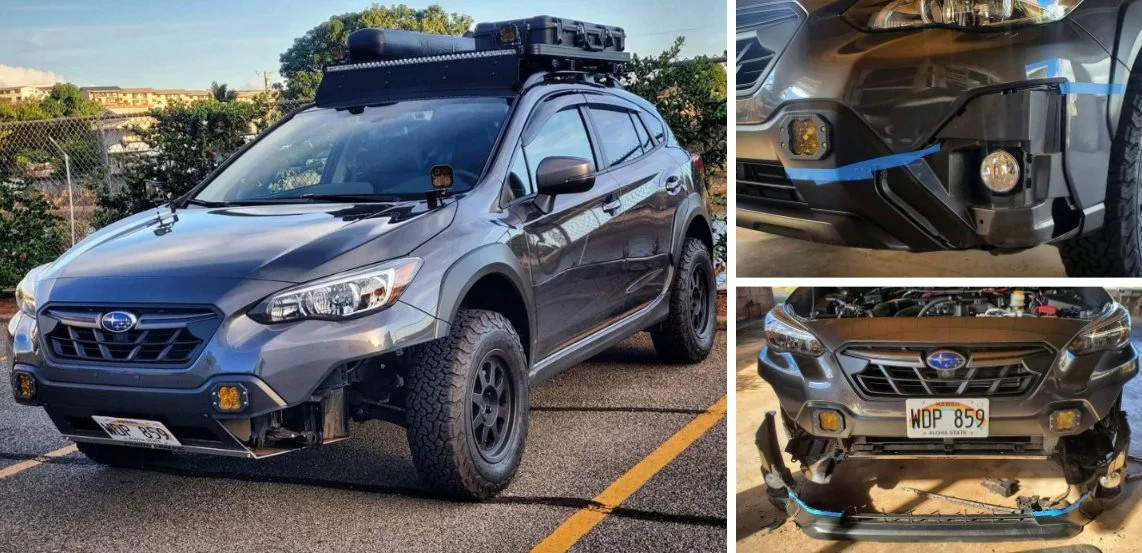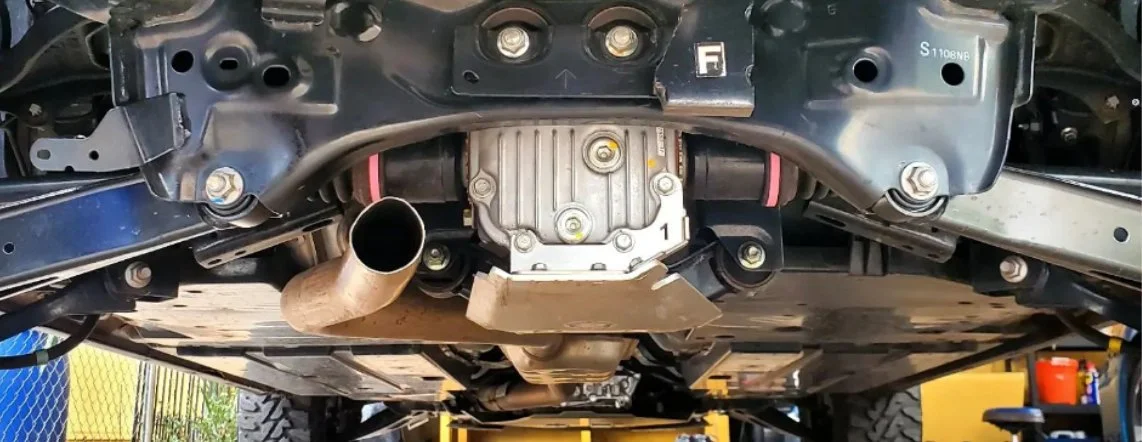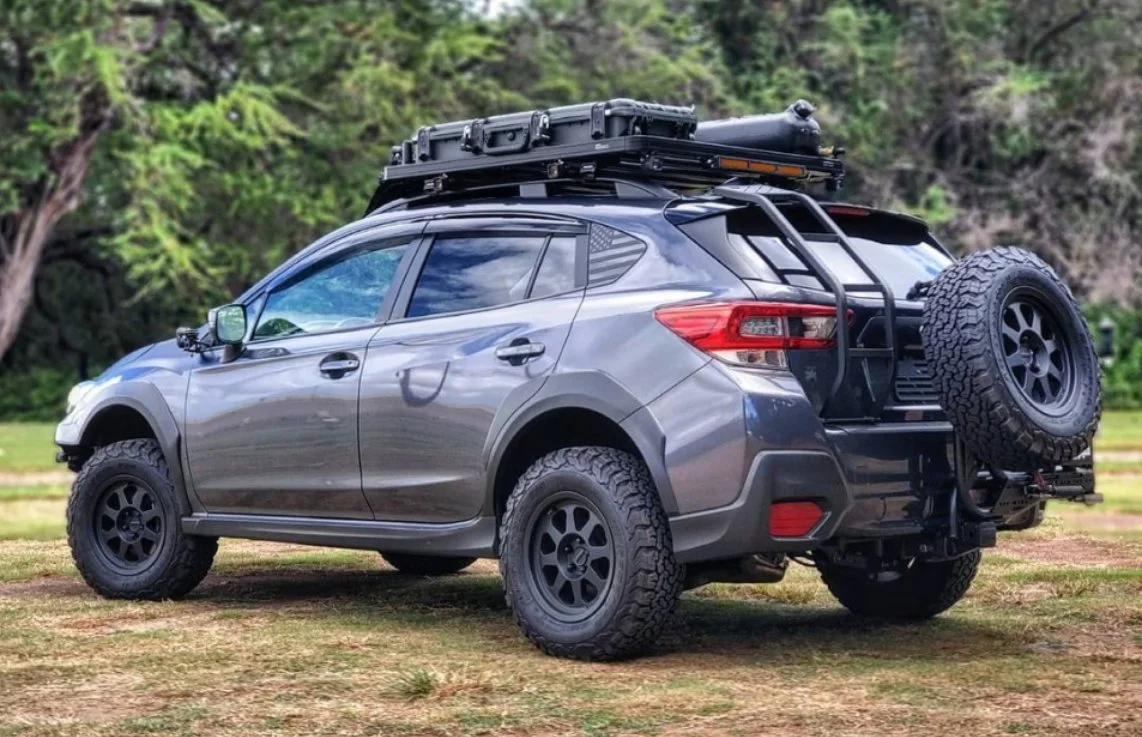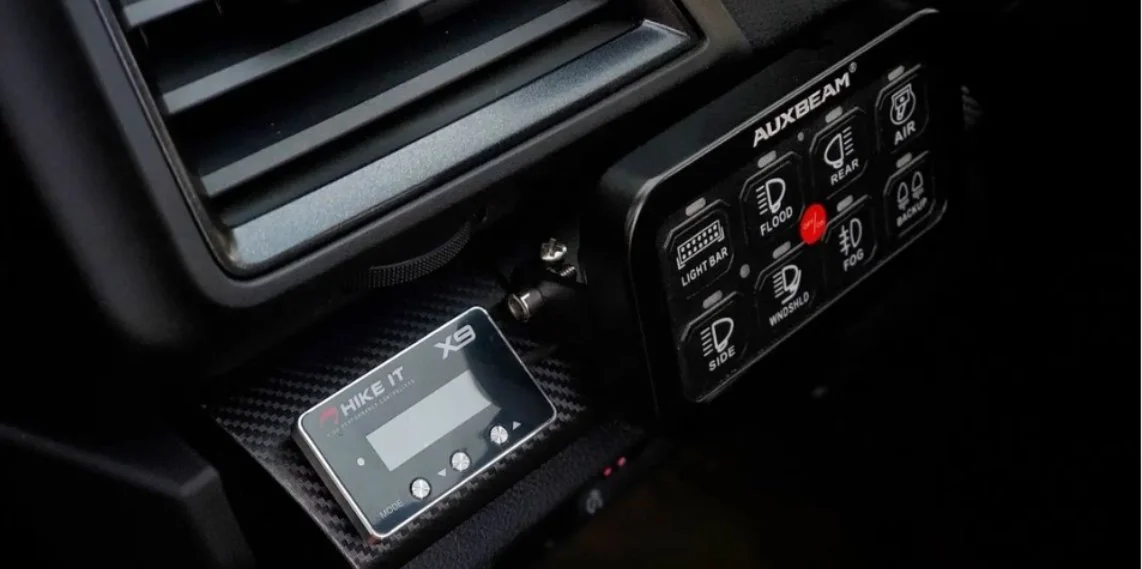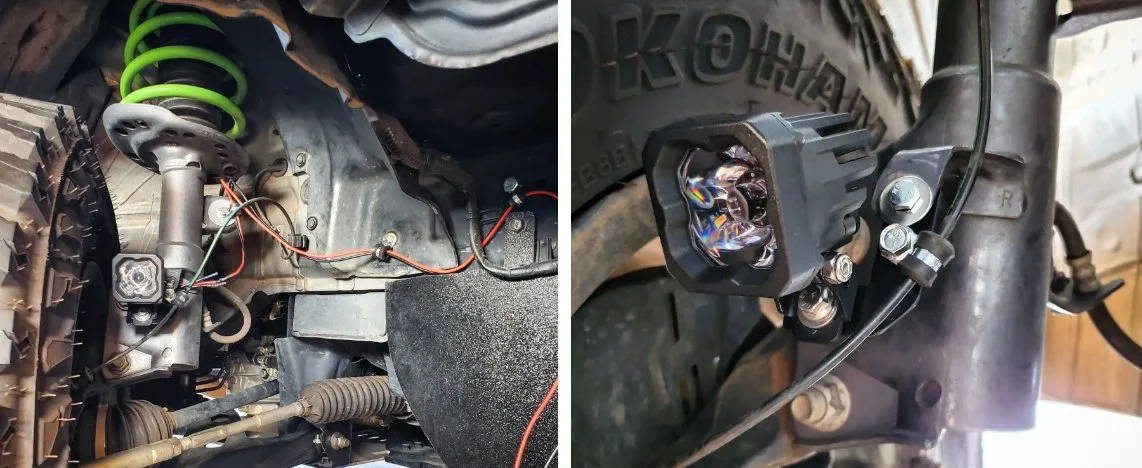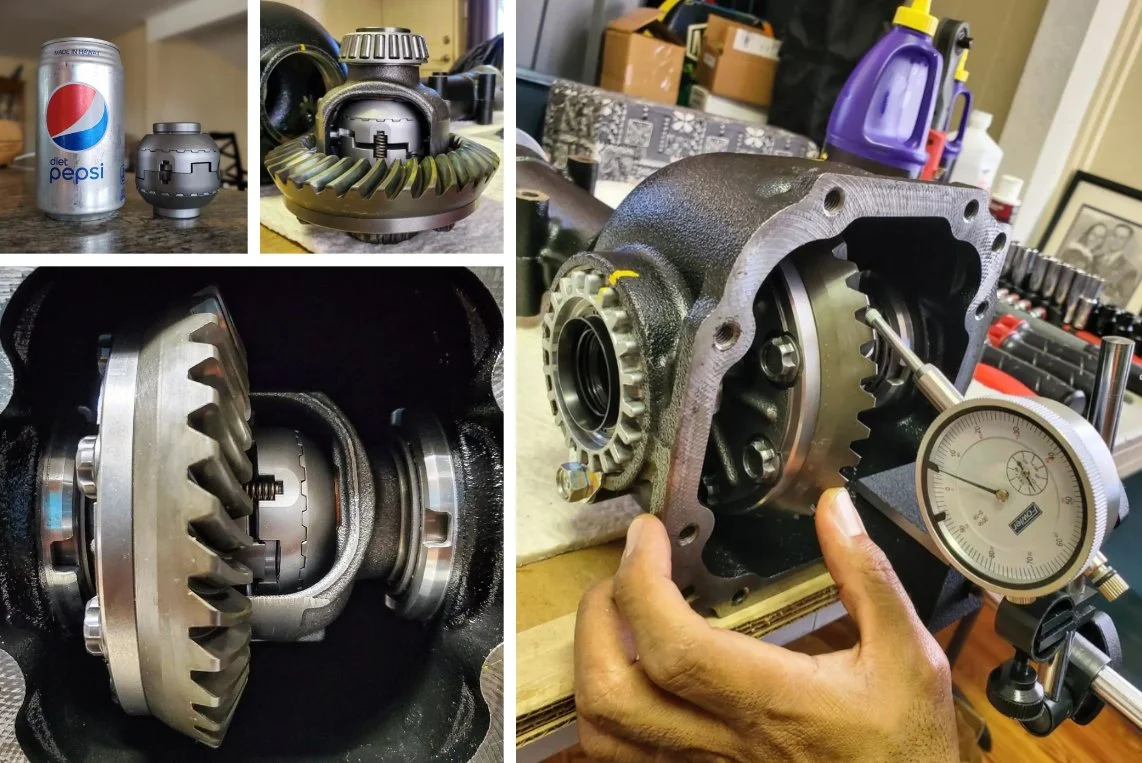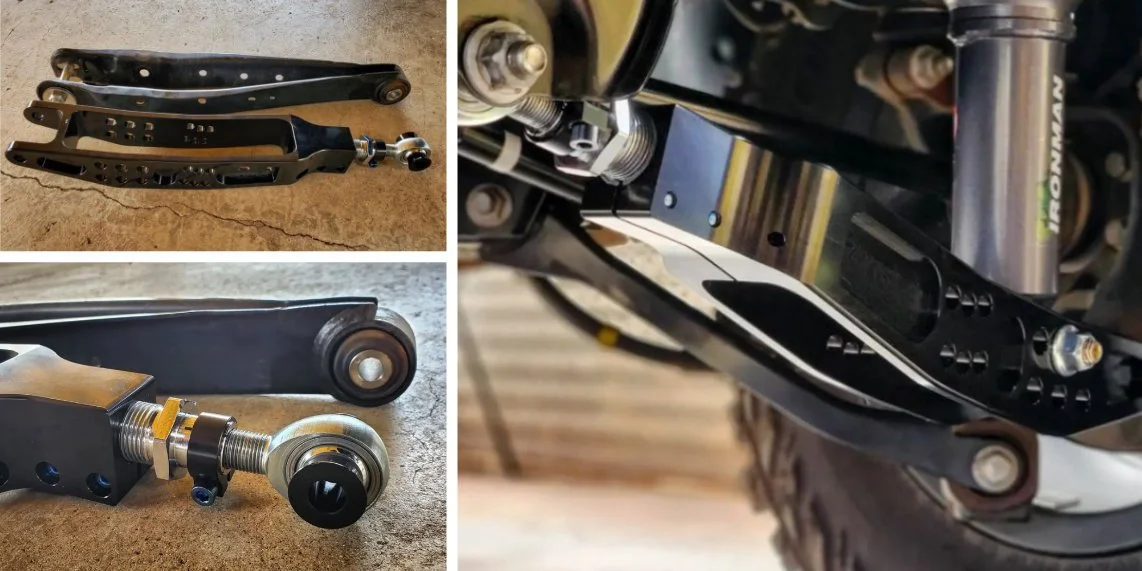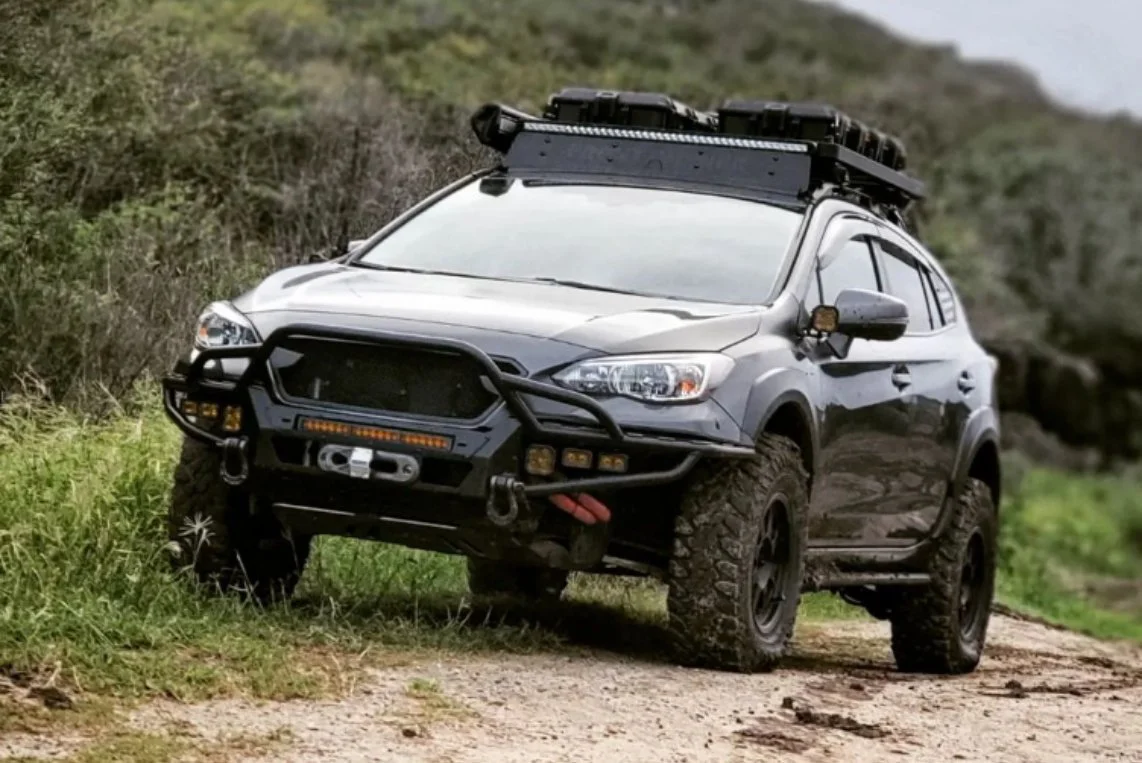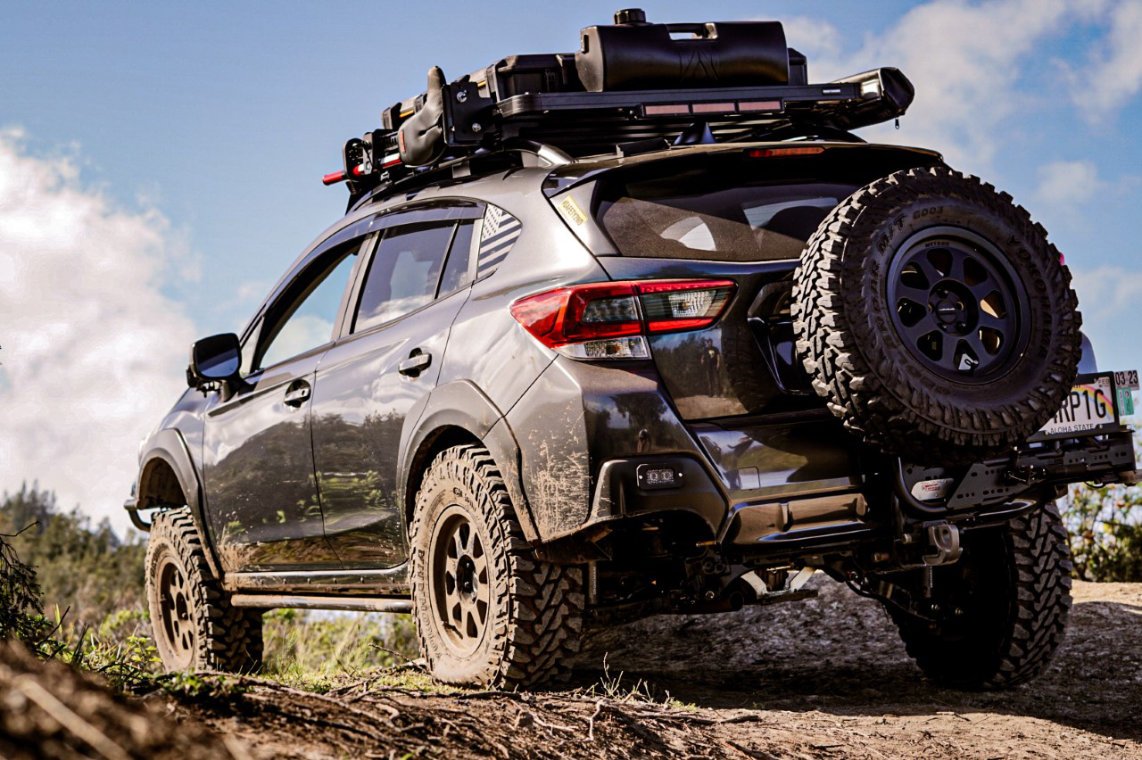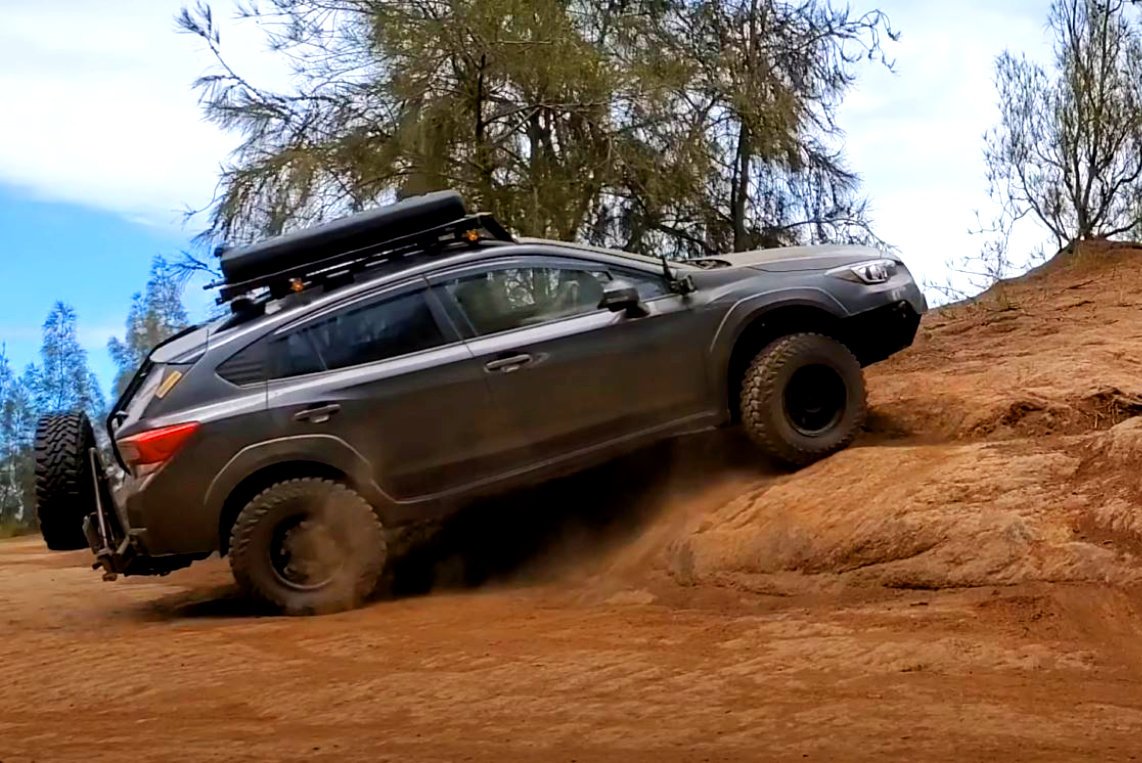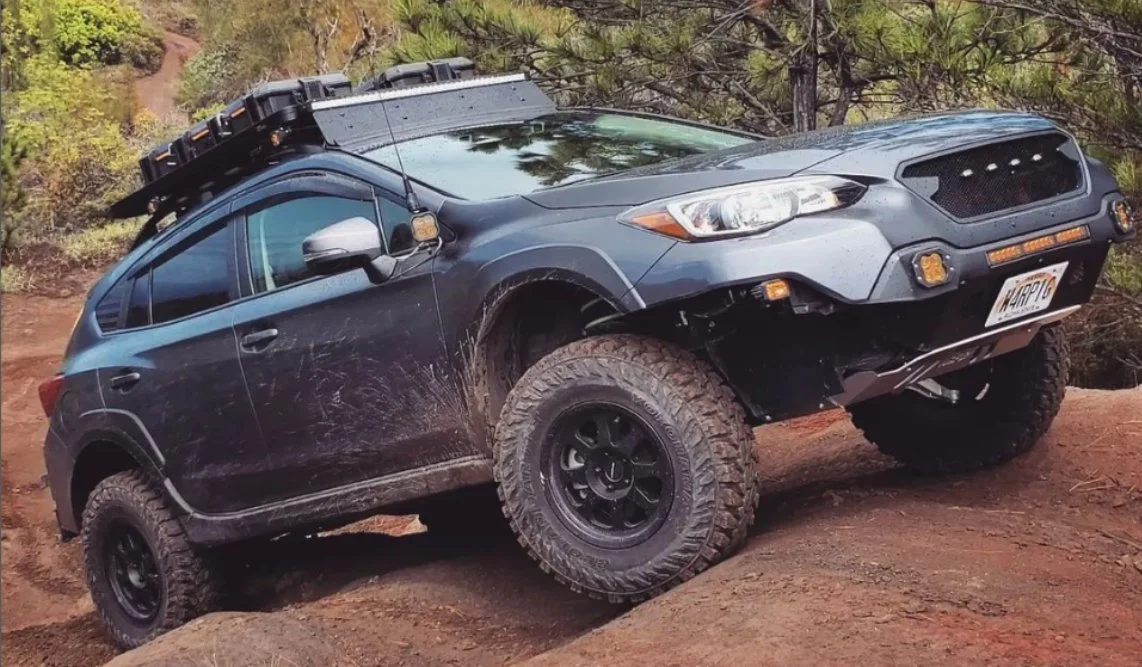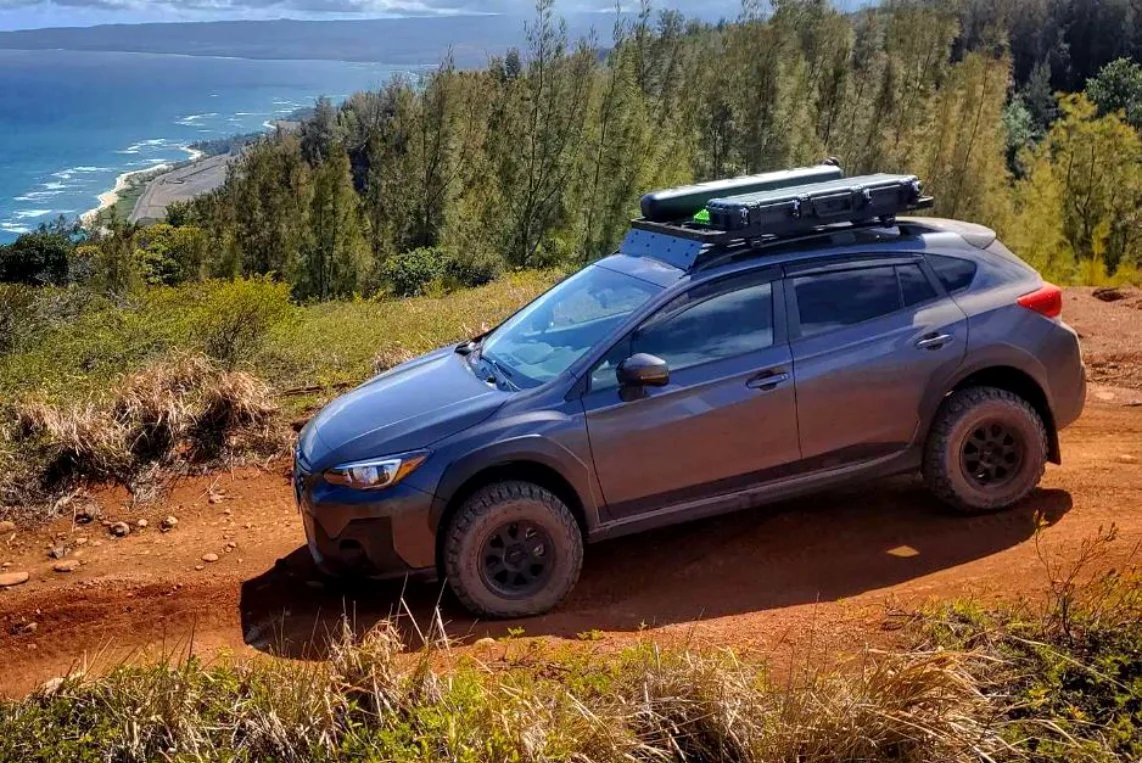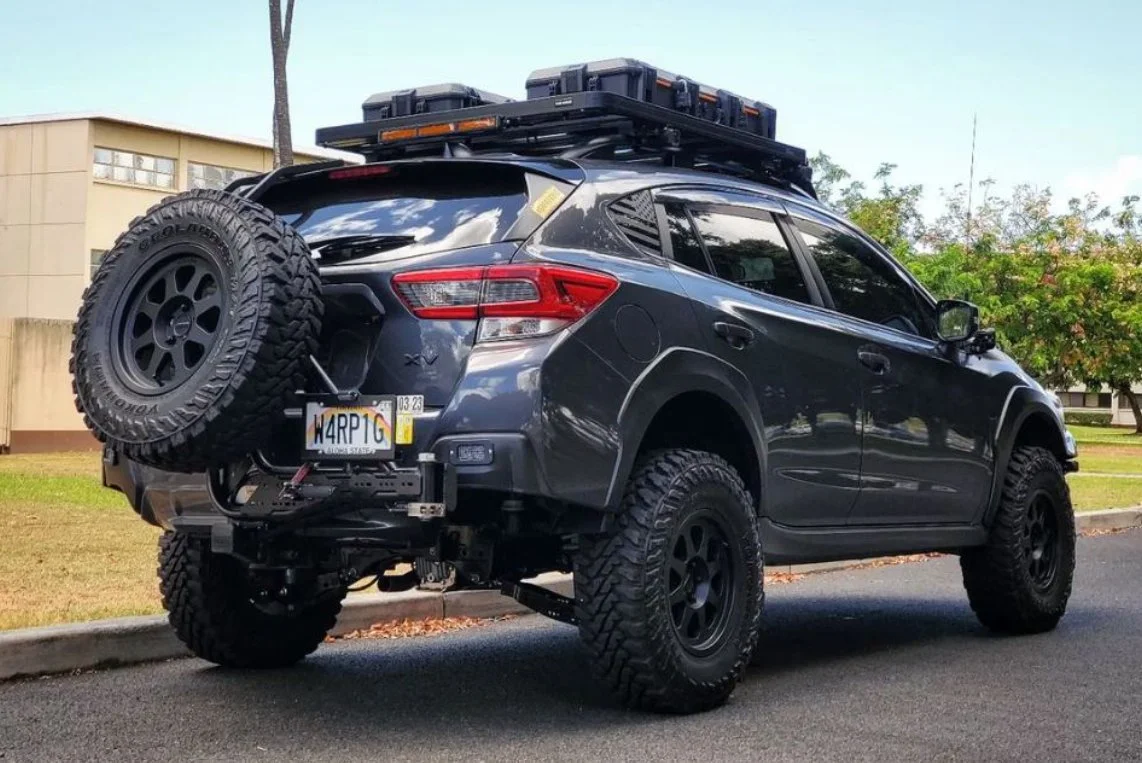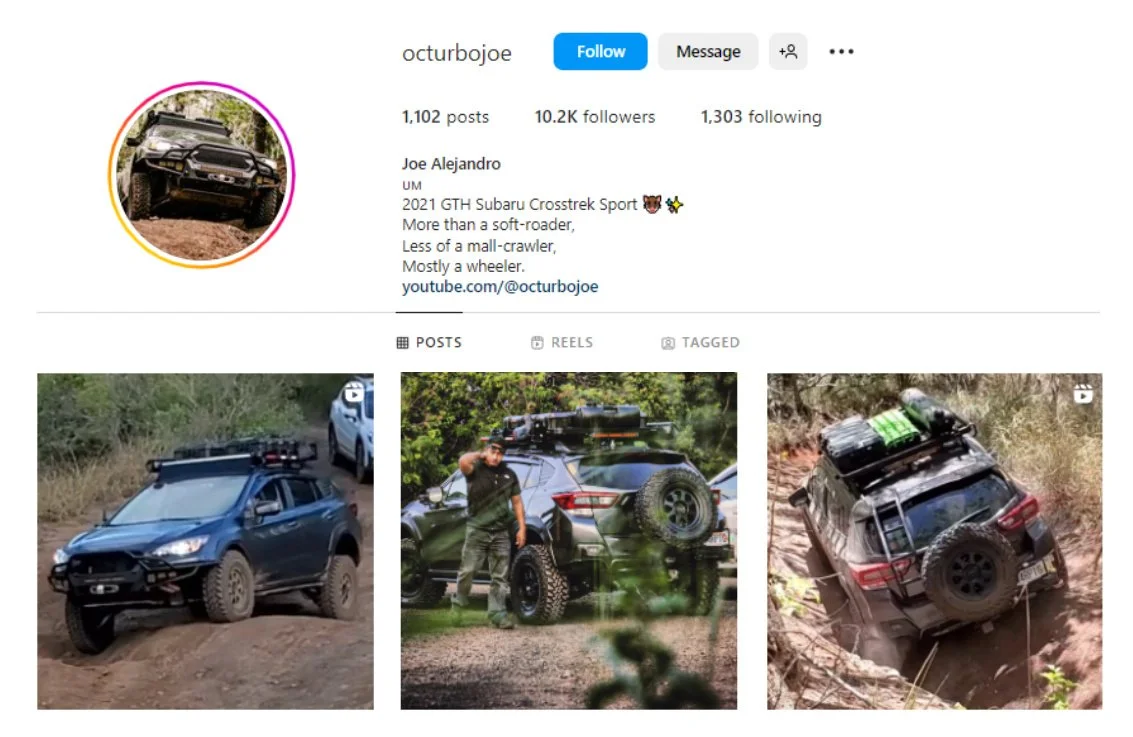Lifted Subaru Crosstrek Modified for Serious Off-Roading
Subaru Crosstreks, also known as the Subaru XV, are quickly growing in popularity among overlanders looking to get off the beaten track.
With a ground clearance rivalling larger SUVs, symmetrical all-wheel-drive, and X-Mode, the Subaru Crosstrek offers a strong platform for off-roading at a fraction of the cost. Subaru is even releasing the Crosstrek Wilderness in 2023 because the Crosstrek has gained popularity as an affordable overlander.
Joe, the owner of this particular 2021 Subaru Crosstrek Sport, resides on the island of Oahu, Hawaii, where overlanding isn't so popular. After all, it only takes five hours to drive around the entire island. Oahu, however, has ample four-wheel driving tracks and parks. So, Joe made it his mission to transform his Crosstrek with the sole purpose of wheeling the island's best trails.
Two years later Joe's Crosstrek, known to the locals as the Warpig, has truly pushed the limits and eats up many of Oahu's best trails.
WRX’s, Instagram, and The Warpig.
The Japanese import scene revolved around Toyota, Nissan, Honda, and Mazda, in the 1990s. But Joe wanted something different.
Subaru had a different approach with a flat boxer engine, symmetrical all-wheel drive, and unique styling. It interested Joe enough to purchase a '94 Subaru Impreza, and since then he has owned nothing but Subaru. Most recently, Joe owned a 2015 WRX STI, which he heavily modified for performance and power. But after six years of ownership and modification, Joe became tired of the sports performance scene and sold his WRX STI.
Joe turned to the Crosstrek Premium for practicality, but most importantly, as a deterrent for modifying the engine to make more power.
But at only 152hp, Joe felt the Crosstrek was too slow on the highway and felt like he was upsetting other drivers. Still, Joe loved the Crosstrek, so he traded it in for the Crosstrek Sport with a larger 2.5-litre engine producing an extra 30 horsepower. The new Sport had an automatic CVT transmission which Joe kindly viewed as his 'kryptonite' against modification. The Sport then settled in as an ordinary daily vehicle and the occasional family trip.
But, that's until Joe logged back into Instagram.
Instagram filled Joe's feed with modified Subarus of all descriptions, including lifted Crosstreks. Most of the Crosstreks Joe followed resided in the United States Mainland or Canada. Most were rocking lift kits, off-road tyres, roof racks, rooftop tents, and brush bars. It was about this time when Joe learned what an 'overlander' was too. Although Joe liked the aesthetic of the overlander style build, much of it is useless as Oahu, Hawaii, is too small for overlanding. Four-wheel driving, however, is popular as there are plenty of access trails leading to remote beaches for fishing, camping, and surfing. The temptation proved too strong and Joe decided this is what he'd set his Crosstrek up to do; to wheel the same tracks as Oahu's Jeeps and Toyotas.
Now it was time to figure out how to build an off-road Crosstrek.
Joe came across Mitre from Ignition Offroad, an Australian who owns an extensively modified dual-range Subaru Forester. Mitre documents the capability of his Forester on YouTube and is excellent at explaining the theory behind each modification to those new to off-roading. Joe shared Mitre's mindset of installing practical modifications and would apply what he learnt from his videos when modifying his Crosstrek.
Slowly, Joe's plan to turn his Crosstrek into an offroader took shape. It was going to be simple; a lift kit, larger off-road tyres, and underbody protection. At least, that was the plan at the time.
Little did Joe know at the time what his Crosstrek would become.
How to Build an Off-Road Subaru Crosstrek.
Joe's build became so much more than a Crosstrek with a lift kit.
In fact, he didn't even kick off his modifications by adding a lift kit. Joe, who makes a living maintaining aircraft, can't feel comfortable until he knows what is happening with his engine and transmission at all times.
He was particularly concerned with the durability of the continuously variable transmission (CVT) when off-roading. He was sure that monitoring the CVT would help prolong the life of the transmission which can be costly to repair or replace.
Safeguarding the Engine & CVT
First, Joe prioritised the installation of an Air Oil Separator by Crawford Performance.
An air-oil separator, coming from the experience of owning a performance-tuned WRX, is essential for all Subarus driven hard. An AOS can extend the life of a flat engine like the boxer by reducing oil consumption and preventing ringland failure in the crankcase.
With the crankcase protected against oil starvation, Joe needed to find a way of monitoring the engine and transmission. Driving the Crosstrek hard on Oahu's trails meant that the chances of part failure would be higher. In particular, the CVT is a concern as slow crawling and climbing on steep trails can elevate operating temperatures quickly. Too much excessive heat can break down CVT fluid prematurely, cause wear and tear, and potentially cause failure.
The ScanGauge II was Joe's choice to display the CVT's temperature in real-time to let him know when it was time to let up on the trail. But knowing the temperature of the CVT is one thing, and keeping it cool while wheeling is another.
The Hayden Auto Internal Bypass Cooler proved to be the best solution by routing hot fluid into a cooler and then back into the transmission. Joe thought this might not be enough for Hawaii's warm weather and installed a 4-inch Push Fan by SPAL to force even more cool airflow into the system.
With engine monitoring and transmission cooling sorted, Joe turned his attention to protecting the undercarriage of his Crosstrek. Subaru designed the Crosstrek to have enough capability to overcome the fire trail, rutted gravel road, or beach access road that most owners may encounter once or twice a year.
However, the Crosstrek has a long front approach angle and there are no guarantees that the ground clearance is always enough, putting low-hanging parts at risk.
The engine sump is most at risk as it could be damaged by unseen boulders or even by abrupt elevation changes. A sizable dent in the engine sump can starve the engine of oil and cause catastrophic issues. Installing Primitive Racing's aluminium skid plate was an easy preventative measure and offers more protection than the factory plastic undertray.
Wheels, Tyres & Roof Racks.
Lift and tyres; the bread and butter of an off-road Subaru.
It is well known in the performance scene that coilover suspension kits are a superior option to cutting springs. Similarly, Joe realised there was also a big difference between a complete suspension lift kit and a spacer lift kit. A full suspension lift, although costing more, provides greater suspension travel, articulation, and better ride quality than a spacer lift. All components in a complete suspension kit work at optimal suspension geometry and operating angles too, resulting in minimal wear and tear to bushings and CV joints.
Joe's preferred choice became Ironman's All Terrain Suspension kit, featuring struts tuned with a 15% overload, a billet subframe, sway bar drop spacers, brake line bracket extenders, high tensile lengthened hardware, and extended muffler hangers. Justifying the extra cost was easy as Joe planned on hitting the trails more than once or twice a month. His goal was to build a dedicated offroader with performance, dependability and comfort in mind. Joe also removed the rear sway bar for extended wheel articulation while installing the new suspension lift. However, Joe advises against removing the rear sway bar until you have a fully engineered suspension setup like this - otherwise, you may notice issues with on-road handling.
Tyres were up next, now that the Crosstrek sat higher to account for larger tyres.
Joe selected BFGoodrich KO2 LT215/75R15s paired with Method MRW701 15×7 5×100 +15 wheels. The new K02's instantly boosted the Crosstrek's off-road performance and weighed only 0.2 pounds heavier thanks to the lightweight aluminium wheels. As such, Joe's fuel efficiency was virtually the same as the factory setup with the new suspension and tyres.
But Joe's MPG is about to take a hit.
Unfortunately, the Crosstrek's larger KO2 tyres were too large to fit in the spare tyre well, originally designed to fit a space-saver. Carrying a full-sized spare can be the difference between driving home or asking a friend with a four-wheel drive for a huge favour. A simple solution is to carry a full-sized spare on the roof.
So, Joe installed a Front Runner Outfitters Slimline II Roof Rack with a Wind Fairing and secured the spare tyre to the rack. There was still plenty of space after securing the tyre, so Joe also fixed an eight-gallon water tank, ARB TRED 1100 recovery boards, and a toolbox. Although the roof rack is made of aluminium, the extra weight and drag hurt the Crosstrek's fuel efficiency. The Crosstrek was now getting 23-25 miles per gallon (10.22 - 9.40 L/100km), a small price to pay for the ability to haul a spare tyre and carry recovery gear. Later in the build, Joe would also fit a high-lift jack to the roof rack as the higher clearance made the stock jack redundant.
It was now time to hit the dirt and test the Crosstrek's new off-road capabilities.
Testing the New Modifications
The Crosstrek performed well on Oahu's Kuaokala Trail with its new suspension and tyres.
But the trail revealed a few limitations, which is understandable given that the Crosstrek was not designed to be a serious off-road vehicle. The new suspension kit improved ground clearance and the rear sway bar delete improved articulation. However, the front articulation was still terrible, so Joe tested removing the front sway bar too. There was a noticeable difference in body roll without the front sway bar, but it wasn't terrible because the Ironman 4x4 ATS suspension kit has higher spring rates and custom-tuned dampers. While Joe has successfully removed the front sway bar, again, he doesn't recommend it to those without a suspension upgrade.
Joe's next problem was the heavy spare tyre on the roof of the Crosstrek.
Roof mounting the wheel solved the issue of carrying a spare, but it also increased aerodynamic drag, and raised the Crosstrek's centre of gravity. Although the Crosstrek has a lower centre of gravity than taller and heavier offroaders, it is still possible to roll over, and the extra weight from the tyre wasn't helping. Joe had a close call and experienced a near rollover firsthand! Joe found a solution in the Dirt Complex Trail Swing installed into an Etrailer Class III 2" Hitch Receiver, a rear tyre carrier that utilises the tow bar, is lightweight and has little effect on departure angles.
After fitting the rear tyre carrier, Joe managed to pop off the Crosstrek's front bumper on the trail.
Subaru designed a low and sleek front bumper to improve fuel economy. But for off-roading, Joe describes the front of the Crosstrek as having 'a chin bigger than Jay Lenos’. Simply put, the front bumper is in the way when climbing and descending uneven terrain because it is low and long.
Replacing the front bumper with a steel or aluminium bullbar with a steeper approach angle has traditionally been the best solution for offroaders. But as this is a Subaru Crosstrek and not a Jeep Wrangler, Joe struggled to find a suitable aftermarket supplier or custom fabricator. Thinking out of the box, Joe had an idea of improving the factory front bumper with the help of an angle grinder. Joe confirmed his idea with the help of Photoshop to trim the front bumper above the hard-wearing plastic bottom end. The cut would require the fog lights to be relocated higher, so Joe figured he'd replace them with LEDs by Diode Dynamics too. Then, the angle grinder worked its way down from the wheel arch, under the grille, and back up to the opposite wheel arch. Joe smoothed the cut with a file when he was finished before lining the edges with rubber seal striping. The trimmed front bar improved the front approach angle and looked great too!
But Joe couldn't rest because there were new problems to fix after trimming the front bar; the undercarriage was now vulnerable to mud, dirt, and stones from off-roading. There were huge gaps on each side where the front bumper hung low and another gap between the skid plate and the front grill. Joe enclosed these areas using thick Kydex sheets lined with heat-resistant shielding to prevent the exhaust manifold from melting the plastic.
Joe's Crosstrek was slowly transforming into the Warpig, and that's when the modifications really started to take off.
Comfort, Lighting, and Functionality.
Larger tyres, a lift kit, and underbody protection certainly increased the Crosstrek's capability. But, there was still much to improve in functionality, lighting, and general comfort.
The Crosstrek's low-hanging exhaust had been on Joe's mind lately; it impeded the vehicle's departure angle and was also in the way of some upcoming suspension work. Taking decisive action, Joe cut the exhaust near the rear differential, increasing the departure angle and opening up more working space. Cutting the exhaust can cause a drone, an annoying noise that occurs when the engine and exhaust vibrate at different frequencies at high speeds. Luckily the Crosstrek's drone was minimal and even sounded sporty above 2,000 RPMs.
While Joe was close to the rear differential, he also relocated the factory differential breather to a higher vantage point.
Slow and challenging off-roading driving generates heat in the differential, and the air within the differential will expand and pressurise. The differential breather will vent out this pressure before it squeezes through the axle seals. This system works well, except when water is involved. Plunging your hot differential in deep water, whether in flood waters or river crossings, can rapidly cool down your differential and cause the air pressure to reverse and suck in the air. If the water level is higher than the differential breather, which is located on top of the transmission, water can be sucked into the differential.
Sand or dirt particles in water can corrode internal metals and cause catastrophic damage over time.
Although the factory breather on the Crosstrek is positioned higher than most street vehicles, Joe was worried about Oahu's hurricane season where flooding is common. And, considering the inexpensive cost and difficulty of installing a breather extension kit, it was a no-brainer for Joe to install one.
Talking about hurricane season in Hawaii, Joe wanted his Crosstrek to have the best visibility possible in poor weather and to light the trail for late afternoon or nighttime four-wheel driving.
Joe planned on installing rear flood lights, auxiliary flood lights, side flood lights, auxiliaries below the front bumper, hood auxiliaries, and front floodlights. Installing individual switches to control each new light would clutter the interior, but installing a switch panel to manage them all would keep things tidy. The 8-Gang Switch Panel by Auxbeam was the best solution, mounted next to the steering wheel, allowing Joe to control all his new lights at the touch of a button.
Lighting certainly wasn't an issue for the WarPig now.
Airing up and down on the trail takes time and energy on the trailhead. Joe decided he'd speed up airing up by connecting the last switch on the Auxbeam Switch Panel to a VIAIR 450C air system with a 2.5-gallon tank securely tucked underneath the back of the Crosstrek. The new air system is compatible with a Prosoport Digital Series Dual Air Pressure Gauge, which Joe installed neatly on the dashboard on a piece of Kydex along with a voltmeter. Joe can now flick on the air compressor and fill the tank while driving back to the trailhead. Then, all Joe needs to do is connect the air hose and air up all wheels simultaneously.
Looking for better access to his roof rack and storage boxes, Joe installed a rear hatch ladder by NashFabCo on the rear hatch. Now, reaching the equipment on the roof is safer than trying to balance on the front or rear tyres. Speaking of tyres, Joe's reversing camera became blocked by the spare tyre after it moved to the towbar. Considering how useful the rear camera is on the trail and in public spaces, Joe relocated the camera to a higher vantage point inside the car using a piece of Kydex.
Tyres, Intakes, and Throttle Controllers.
The Crosstrek was progressing well. But to increase the Crosstrek's capabilities, Joe had to push it even further.
In the quest for maximum off-road performance, Joe purchased a set of Yokohama Geolandar M/T G003 30x9.5x15 tyres. Moving up in size from 28.5 to 30-inch mud terrains isn't for the faint-hearted, though. Without permanent alterations to the Crosstrek, the 30-inch tyres will rub inside the wheel well, hinder the steering angle, and prematurely wear out. But Joe doesn't shy away from any alteration that will enhance his Crosstrek.
Picking up his trusty grinder, Joe ground down the pinch weld inside the wheel well, cut a few inches off the fender, and used a heat gun to bend the fender liner away from the wheel.
After confirming the new Geolandars moved freely at full lock and articulation, Joe applied paint to the raw pinch weld and sealed the cut fenders with rubber u-trim. Lastly, Joe trimmed the reflectors from the rear bumper to achieve a steeper departure angle.
Joe had also noticed the ATS springs that came with the Ironman Suspension kit had started to sag under the weight of the WarPig's new accessories. Luckily, Ironman released new Spec-C springs, engineered to handle more weight than the previous generation springs. Joe ordered a set and also one-inch strut HDPE spacers by Subtle Solutions to raise the Crosstrek a little higher to combat any future sag. The installation of the new springs was straightforward, however, the HDPE spacers required modification to sit flush on top of Ironman's Spec-C struts.
The WarPig now sat roughly four inches higher than a Crosstrek fresh from the dealership floor.
The CV joints sat at an acceptable angle of 1.3° and the brake lines were under no stress even at full tyre droop. Joe even estimates that another 0.5 lift is doable without serious work on the suspension geometry and brake lines. But with the larger tyres and around 200lbs (90kg) of accessories, the Crosstrek's 2.5-litre engine started to feel unresponsive again and even slower than stock.
Joe needed to remedy the Crosstrek's unresponsiveness and return it as close to stock performance as possible. There were two ways he thought this could be possible; improve throttle response and increase airflow.
Beginning with throttle response, Joe acquired and installed a Hike It X9 Throttle Controller. A throttle controller won't increase horsepower but allows the throttle to be tuned to feel more responsive. In practice, the accelerator will produce power with less pressure. Joe felt the Crosstrek was much closer to how the car responded when it had 28.5-inch tyres, once the throttle controller was installed.
Throttle control is only one half of the story, as airflow is king. More airflow means better explosions and more power. Enter the Takeda Momentum Intake System by aFe Power, which claims to create a 19% improvement in airflow, 4+ horsepower, and +5 lbs of torque.
Forcing colder air into the intake system had the engine pulling harder, and with the new throttle controller, it felt like the Crosstrek had the power back lost to the larger tyres and additional weight.
Aerials, Lockers, and Control Arms.
Satisfied with the Crosstrek's acceleration, Joe returned his attention to making life easier on the trails by installing a MidlandUSA aerial. Joe could now communicate with other vehicles and a spotter without worrying about the batteries running out on a portable UHF radio.
Joe also dreamt up another system that would make his life much easier on the trail, particularly in low-light visibility.
The Crosstrek doesn't have adaptive steering lights, and this can make it difficult at night to see obstacles like boulders and drops when turning sharply on the trail. Although the Crosstrek has a lightbar on the roof rack, the high angle can create deceptive shadows. A lower vantage angle that moves where the wheels face will create a more accurate picture of what is directly in front of the wheels. With a pair of SSC1 LEDs by Diode Dynamics, Joe invented his own adaptive steering lights that mount to the suspension's lower strut, at the expense of needing to relocate an ABS cable.
Next, Joe purchased an automatic rear locker from Torq-Masters.
Off-roading on uneven terrain in a vehicle with independent front and rear suspension will inevitably result in a wheel or two hanging loosely above the trail. Where there is no contact with the ground, there is no traction, therefore, no forward movement. Most road-orientated vehicles will send power to the wheel with the least resistance, but for off-roading, this is bad because power is sent to the wheel hanging loosely over the ground.
Then the vehicle is stuck hopelessly in place spinning the wrong wheels. In scenarios like these, Subaru's symmetrical all-wheel-drive and X-Mode systems offer better performance than most other all-wheel-drive systems. However, these systems have their limits, especially when tested by technical terrain.
An automatic locker like the one made by Torq-Masters will force the driveline to split the power evenly to both wheels and force traction to the tyre that remains planted on the ground.
When Joe ordered his Torq-Masters locker there was no guarantee it would be compatible with the factory differential in his 2021 Crosstrek Sport. Joe played it safe and purchased a differential from a 2020 Forester Premium, knowing it would work with the locker, and fit on the Crosstrek thanks to Subaru's Global Platform. Later on, Joe discovered that the Torq-Masters locker was compatible with the factory differential on his Crosstrek Sport. But, Joe decided to keep this differential as a spare for a future 4.11 gearing upgrade.
Installing the Torq-Masters locker can be tricky for those new to wrenching. There are a few important things to watch out for; adjustment to the Ring Gear and Drive Pinion is necessary to reduce back-and-forth play, the Gear Contact Pattern needs to be dead centre for minimal wear and tear, and the Companion Flange runout needs to be in harmony with the Round Companion or it can lead to excessive vibrations in the drivetrain. Being mechanically minded, Joe bought all the necessary tools and equipment to install the automatic locker properly. He also decided to replace all seals, gaskets, and o-rings on the new differential from the 2020 Forester as he didn't know about its previous life. A few off-road tests later and Joe could instantly feel the difference the automatic locker made on the Crosstrek. In short, it made challenging climbs easier and opened up more advanced sections of the trails.
Subaru's engineers hadn't designed the Crosstrek for the amount of stress that technical off-roading would transfer to suspension and drivetrain components.
Bushings, the rubber cushions between moving parts, reduce vibrations and limit movement in suspension and steering joints. Off-roading, however, places extra load on the bushings through greater and more frequent articulation. Hard acceleration can also wear bushings, such as differential cradle bushings. The Crosstrek's differential cradle bushings are durable, however, they are designed with small gaps to mitigate the twisting forces generated by the driveshaft under heavy acceleration, therefore maintaining driver comfort. But, heavy acceleration required to power through an obstacle or up a steep section of track can prematurely wear out these bushings. Furthermore, the gaps in the bushings can reduce initial torque, which Joe needed all he could get. So, he installed Rear Differential Mount in Cradle Bushings by Whiteline. These mount-in cradle bushings fit into the gaps within the cradle bushings to provide a tighter and more responsive feel. What's more, they also increase the lifespan of the original bushings.
The Crosstrek's front and rear control arms are another component that Subaru hasn't designed for aggressive off-roading.
The rear and front control arms are core suspension components that allow the vehicle to steer and maintain contact with the road surface. The original control arms on the Crosstrek are designed to operate at factory ground clearance with standard-sized tyres. Driving with 30-inch tyres and a three-inch suspension lift will understandably shift the suspension geometry and throw components into conditions that aren't optimal for longevity. There is also a heightened risk of damage to the control arms from unseen boulders on the trail that can cause steering or articulation issues. Luckily, Subaru is now designing front control arms designed for higher ground clearances and off-road durability thanks to the Wilderness models of Foresters, Outbacks and the upcoming Crosstrek.
Thanks to Subaru's Global Platform, the front control arms from the Outback Wilderness are compatible with the Crosstrek Sport. The Wilderness has a higher ground clearance than a base model with different control arms to suit steeper suspension angles to reduce wear on ball joints and bushings. The Wilderness control arms are also constructed from stronger and lighter aluminium to handle offroad environments.
With the front control arms fitted from the Outback Wilderness, Joe needed to find a solution for the rear control arms and trailing arms.
Joe selected Aluminium Rear Lower Control Arms by Torque Solution, initially designed for the WRX/STI or FRS/BRZ to correct suspension geometry for lowered vehicles. However, as they are adjustable, they can be configured to suit higher clearance on lifted Crosstreks, while providing greater strength, clearance and less weight than factory control arms.
The weakest remaining part of the suspension in the Crosstrek was now the original rear trailing arms; one significant hit on the trail by a boulder can mean the car is either limping home or on the back of a trailer. Turning to the performance market again, Joe installed a pair of Rear Trailing Arms by Megan Racing, manufactured with a thicker, yet, lightweight alloy steel with spherical bushings that provide more freedom of movement.
Rock Sliders, and Hybrid Bullbars.
Coming to the final stage of the build, Joe upgraded his skid plate to an ASFIR 4x4 Front Skid Plate, which offers greater side impact protection. Joe also installed the rear differential and gearbox plates that ASFIR provided.
The final upgrades to the Crosstrek were a set of rock sliders and a front bar.
Starting with rock sliders, Joe needed to protect the Crosstrek's skid skirts which had proven to be a vulnerability on the trail. The Crosstrek has a limited break-over angle and the side skirts can become hung up on the apex of a slope. Too much weight balancing on the side skirts can bend the frame, cause panel damage, and stop the doors from opening or closing freely. Although there were aftermarket sliders for the Crosstrek, Joe felt that these weren't strong enough for his style of four-wheel driving and limited ground clearance.
Another Crosstrek owner, @thtguysly, who wheels his vehicle like Joe also felt there lacked a suitable rock slider product on the market. Teaming up with each other, they approached Full Force Metalworks, a small family-owned custom fabrication shop in Tennessee that specialises in Subaru customisation. Joe and @thtguysly provided some suggestions, and Full Force Metalworks was eager to develop a new product for the market. After three design changes, Joe received the new sliders from Full Force Metalworks, which fit between the chassis and front control brackets.
With the success of the rock sliders, Joe and @thtguysly also worked with Full Force Metalworks to produce a new hybrid front bar for the Crosstrek.
Full Force Metalworks designed the new front bar to suit Joe and @thtguysly's requirements; lightweight, winch compatible, lighting mounts, and even high-lift jacking points. Full Force Metalworks finished product weighed only 83 pounds (37.65kgs) and bolted straight into the Crosstrek's factory mounting points. As it is a hybrid design, it was necessary to trim the front bar under the headlights to make it fit, which Joe had a bit of experience with at this point. But before installing the new bar, Joe fitted a Super ATV 6K Black Ops winch and mounted up his new lighting set-up.
And just like that, the bulk of Joe’s build is complete! So, what can an extensively modified Crosstrek do when the road ends?
Modifications:
Suspension & Lift -
Lift Kit: Anderson Design Fabrication 1" Front Lift Spacers & 1" Rear HDPE spacers by Subtle Solutions.
Suspension: Ironman 4x4 ATS 2-2.5" Lift (w/ Spec-C Springs).
Lower Trailing Arms: Megan Racing Rear Trailing Arms + Torque Solution Rear Lower Control Arms.
Front Control Arms: Subaru 2020 Outback Wilderness Front Control Arms
Sway Bar: Front and rear delete.
Tyres & Wheels -
Tyres: Yokohama Geolandar 30-inch M/T G003 Tires
Wheels/Rims: Method Racing MRW701 15×7 5×100 +15
Tyre Carrier: Dirt Complex Trail Swing + Etrailer Class III 2” Hitch Receiver
Drivetrain -
Driveshaft: ADF 3/4" Driveshaft Carrier Bearing Spacers
Transmission: Hayden Automotive 699 Transmission Cooler + 4" Push Fan by SPAL.
Rear Locker: Torq-Masters 1-Bolt Locker installed on a VA1 Forester Premium Rear Differential.
Differential Bushings: Torque Solution Rear Differential Bushings and Rear Differential Mount in Cradle Bushings by Whiteline.
Protection & Recovery -
Front Bar: Full Force Metalworks hybrid front bumper.
Rear Bar: Dirt Complex Trail Swing & NashFabCo Rear Hatch Ladder
Sliders: Full Force Metalworks Rock Sliders
Winch: Super ATV Black Ops
Undercarriage Protection: ASFIR Offroad Engine Skid Plate + differential and gearbox plate.
Recovery Points: 4122inc Hitch Slider & Curt MFG Class III 2" Hitch Receiver
Mudflaps: DIY Kydex + Rubber
Recovery Boards: ARB TRED 1100
Differential Breather: Relocated to a higher point.
Air Pressure Gauge: Prosport Digital Series Dual Air Pressure Gauge
Onboard Air Compressor: VIAIR 450C air system with a 2.5-gallon tank.
Aerial: MidlandUSA connected to a SMKFabrication mount & MXT275VP4 Mobile GMRS Radio.
Jack: High-Lift Jack with a Front Runner Outfitter Slimline II Holder.
Lighting & Storage -
Roof Cage: Front Runner Outfitters Slimline II Roof Rack + Slimline II Wind Fairing
Rear Ladder: NashFabCo
Toolboxes: Pelican V700 Takedown Cases
Front Door Molle: Orbis Overlanding Molle Panel
Lighting:
Lighting Gauge: Auxbeam 8-Gang Switch Panel
Headlights: Boxer Overland Trail Pro Combo Headlights & Diode Dynamics SS3 Sport Flush Lights
Fog Lights & Hood Auxiliaries: Diode Dynamics SSC2 Front Fogs, SS 18" LED Driving Light & SS3 Sport Ditch Lights
Rear Flood Lights: Diode Dynamics
Reverse Lights: SS 18" LED Rear Chase Light & SSC2 Reverse Floods
Side Flood Lights: Diode Dynamics SSC1
Lightbar: Rigidhorse 42" Single Row LED Bar
Adaptive Steering Lights: Diode Dynamics SSC1
Exhaust & Performance -
Vehicle Monitoring Gauge: ScanGauge II
Throttle Controller: Hike It X9 Throttle Controller
Intake: AFEPower Takeda Momentum Intake
Air Oil Separator: Crawford Performance.
Exhaust: Cut near the rear differential
How Capable is an Off-Road Crosstrek?
Joe’s Crosstrek has undergone an extensive transformation to become an offroader. But is it much more capable than a stock standard Crosstrek?
Absolutely!
Joe is comfortable following Toyotas and Jeeps into intermediate trails in his Crosstrek. However, that doesn't mean Joe heads into trails blindly or that the Crosstrek is without disadvantages compared to a Jeep Wrangler or Toyota 4Runner.
When driving the Crosstrek on a new trail, Joe scouts ahead on foot to see what obstacles are ahead and whether the Crosstrek can handle them.
Sometimes, this means turning back. Joe's general experience on the trail is that most obstacles are passable, although doing so may need some strategy rather than just powering through with huge wheels and clearance. Joe has driven his Crosstrek on the trail with this pragmatic mindset, pushing the car a little further each time to discover its advantages and disadvantages. Each time a drawback was discovered, he looked for a fix. Then, he tested it out in the field to see whether it improved the Crosstrek. As a result, Joe has a feel for the Crosstrek's capabilities and is confident on the trails.
Joe frequently drives the Peacock Flats and Ka'ena Point trails on the Hawaiian island of Oahu, popular for their deep ruts, gulleys, steep climbs, and rock gardens. There are many other trails on Oahu too, but being a small island, these are a well-kept secret to keep them pristine. But, you can watch Joe tackle these trails on YouTube or Instagram where he documents the capabilities of his vehicle.
It can be a little intimidating for new Crosstrek owners to watch Joe driving fearlessly into four-wheel drive trails in his heavily modified Crosstrek. Remember, though, that Joe did not wait for his Crosstrek to be 100% complete before hitting the dirt.
A new or prospective Subaru Crosstrek owner doesn't need to spend the time or money that Joe has invested into his vehicle to start off-roading. Joe began off-roading his Crosstrek the minute he swapped his road tyres for mud terrains. There are plenty of places a factory Crosstrek can handle, and plenty of fire trails, beaches, and forest roads that are accessible with relatively inexpensive modifications like larger all-terrain tyres, a lift kit, and a sump guard.
Road tyres are the prevailing limitation for a standard Crosstrek as they lack traction on the trail. Simply switching to all-terrain or mud-terrain will dramatically increase the traction the Crosstrek can achieve. Clearance becomes the next limiting factor, particularly the approach angle due to the depth of the Crosstrek's front bumper. The inherently long front nose is aerodynamic but not great for offroading. Steep inclines or boulders can pop off the front bumper on trails more advanced than a fire or access road. Trimming the front bar or upgrading to a hybrid or full bullbars will quickly improve the Crosstrek's approach angle.
It's not all bad news for the Crosstrek though; it has advantages over other softroaders like the Forester, Outback, and even dual-range four-wheel drives.
The Crosstrek is compact, light, and has a lower centre of gravity. The Crosstrek is nimble on tight trails and needs to move less weight on sand and snow. On uneven, steep, or sloping terrain, the low centre of gravity also reduces the chances of a rollover. And over conventional four-wheel drives, the Crosstrek has low running costs as there is no dual-range transmission system to maintain. All in all, the Crosstrek offers competitive off-road capability in the mid-compact category and is surprisingly capable with a few modifications.
Joe recommends three supporting modifications for those looking to chase the capabilities of the WarPig, aside from larger all-terrain tyres, a lift kit, and a sump guard.
Joe is a big believer in the value of the Hayden Automotive 699 thermostatic transmission cooler to keep the CVT in optimal operational temperatures while under extraordinary stress on the trail. Along with regular CVT fluid changes every 30K miles (48,000 km), Joe is confident his transmission cooler will help prolong the life of this CVT and increase performance on the trail. Joe's second recommendation is the Scangauge II OBD Monitor that displays oil temp, CVT temp, air intake temp, and coolant temp. Joe has the benefit of being able to monitor his engine in real time before any costly issues arise. Lastly, Joe is a big fan of the Torq-Masters 1-Bolt Rear Locker. Any Crosstrek owner looking to push the vehicle to the limits should look into purchasing one. While X-Mode is effective in many scenarios, the Torq-Masters rear locker goes even further to provide a 50/50 front and rear torque split to overcome advanced obstacles.
What’s next for the Warpig?
The Warpig has come a long way since it left the dealership in 2021.
With the addition of a hybrid front bar, winch, and rock sliders, Joe is continuing to test the capability of the Crosstrek and improve its performance even further. For instance, Joe is interested in swapping the drivetrain from a 2022 Forester Wilderness which has a lower crawl ratio. Ideally, a dual-range transmission would be better, but there are few viable options on the market. Stronger CV axles to support larger tyres and higher suspension geometry is also on Joe's wishlist. Joe has been chasing a high-quality snorkel kit to protect his Crosstrek from torrential rain and flooding in Oahu too. And, lastly, most Crosstrek owners are interested in a supercharger kit to add more power and torque on the trail.
Joe is interested in working with the right aftermarket supplier to develop a good product for the items on his wishlist, similar to his collaboration with Full Force Metalworks.
Riding away in the Hawaiian Sun.
Joe has enjoyed testing the limits of his Crosstrek and the people he has met along the way.
The off-roading community in Hawaii is friendly, supportive, and collaborative. Subaru owners like @snakenmyboots, @goadvtr, and @Ignition_Offroad have been helpful despite being far away. Joe hopes his presence on social media is also helping other Crosstrek owners improve their vehicles and hit the trails.
Joe's advice to anyone modifying their Crosstrek or softroader is to be honest about the limitations of your car.
Social media highlights the most unique, elaborate, and expensive project cars. But there's no point copying a build if it doesn't suit your lifestyle or budget. Start small with all-terrain tyres, a quality lift kit and a skid plate. Then, go out and test your vehicle, learn how it handles and tweak your driving style to suit. Know your limits and don’t be afraid to seek advice from those who regularly drive off-road whether it’s another Subaru owner or a seasoned four-wheel driver.
But most importantly, Joe’s final piece of wisdom is to take care of the trails and don’t destroy them for fun or social media clout. One minute of fame can lead to trail shutdowns and cost those who follow the rules a chance to enjoy them.
Follow along with Joe as he continues to push the limits of his Crosstrek on Instagram and YouTube. Special thanks to @photosbydom808 for images.

